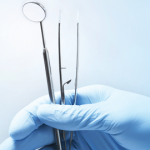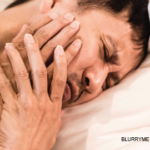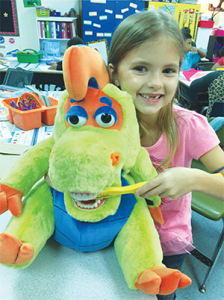 Look inside the oral cavity of a patient for answers that go beyond what we perceive as the dentist’s domain. So goes the thinking of medical professionals interested in how oral health and bacteria-driven disease, such as periodontitis, may be linked to rheumatic disease, especially rheumatoid arthritis (RA).
Look inside the oral cavity of a patient for answers that go beyond what we perceive as the dentist’s domain. So goes the thinking of medical professionals interested in how oral health and bacteria-driven disease, such as periodontitis, may be linked to rheumatic disease, especially rheumatoid arthritis (RA).
Bad bacteria that live in the mouth can cause gingivitis and periodontitis, which pose risk to a patient’s oral health and could lead to loss of bone and teeth. Plaque, a destructive film of bacteria found on and in between teeth, contributes to these different stages of disease that leave the gums swollen and inflamed, but what happens when those bacteria enter the bloodstream and move through the body?
Periodontitis & RA
For several years, researchers have investigated associations between RA and gum disease, also known as periodontitis. Research conducted at Johns Hopkins Arthritis Center by Clifton Bingham III, MD, associate professor of medicine and director of the center, and research fellow Malini Moni, BDS, MS, found that out of 100 RA patients studied, 70% had gum disease and 30% had severe gum disease, which was much higher than among the 40 healthy participants (35% of whom had gum disease and 5% of whom had serious gum disease).1
Chronic inflammation is common to both RA and gum disease, and some theories explore the possibility that infection of the mouth may travel into the bloodstream and trigger inflammation and disease elsewhere in the body. But whether one disease causes the other is not clear.
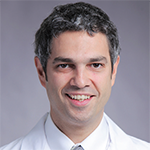
Dr. Scher
“What’s been known for several decades now is this idea that periodontal disease at a population level is significantly correlated with rheumatoid arthritis and rheumatoid arthritis activity,” says Jose U. Scher, MD, a New York University School of Medicine assistant professor of rheumatology and director of the Arthritis Clinic and Microbiome Center for Rheumatology and Autoimmunity at NYU Langone Medical Center.
Exactly what causes RA is still unknown, and whether periodontal disease is a triggering factor remains to be seen, explains Dr. Scher to The Rheumatologist. Perhaps more important, he notes, is the question of whether both could be treated in a concomitant fashion.
“If you could treat rheumatoid [arthritis] patients with periodontal disease with both rheumatoid [arthritis] medications and periodontal nonsurgical approaches, then that would be the ultimate answer,” says Dr. Scher. “It has not been done yet.”

Ms. Slusher
Further exploration is needed to more efficiently identify signs of gum disease among people with RA, note the authors of a special report on the topic published in the International Journal of Clinical Rheumatology.2 Early research indicates that a combination of self-report questionnaires and assessment of risk factors could be used to quickly identify and evaluate RA patients who may benefit from a full-mouth examination and periodontitis treatment, states the article.
Other studies have investigated how dental disease relates to illnesses systemically throughout the body, including heart disease and diabetes. A recent study published in PloS One showed that periodontitis was associated with an increase in cognitive decline in patients with Alzheimer’s disease.3
Importance of Oral Health
Although researchers say that many questions on possible links between rheumatic disease and periodontal disease require further study in human clinical trials, they tend to agree that oral health is important for all patients living with RA. Johns Hopkins recommends that patients with RA regularly get complete oral exams and be sure to tell their dentist about their disease.
Because we know that gum disease in adults could contribute to or at least exacerbate systemic diseases, teaching the young to adopt good oral hygiene habits makes sense. That’s a goal of a group of student physician assistants from the University of Texas Medical Branch (UTMB) at Galveston, that launched a project to work with first-graders who are learning how to properly brush their teeth.

PA student Justin Brewer uses Alexander Alligator to teach a student about brushing in circles.
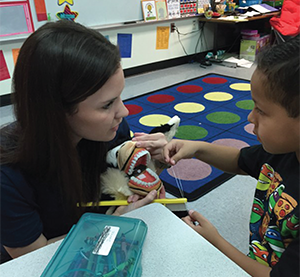
PA student Kelsey Berg uses Mojo Monkey to show a student tricks to flossing.a
The PA students were guided by Barbara Slusher, MSW, PA-C, assistant professor of physician assistants at UTMB Galveston, also a PA whose specialty is rheumatology. She says the PA student project highlights how important oral health is by going beyond an emphasis on the cosmetic benefit of clean, white teeth.
“We’re trying to whack at the root,” says Ms. Slusher. “We’re trying to tell children early on that it’s important to take care of their teeth and link it to their physical health.” The graduate students dubbed their community outreach project with the acronym TOOTH, which stands for Teaching Others Oral Treatments & Health. The project is based on the Smiles for Life Campaign, a national oral health curriculum originally developed in 2005 by the Society of Teachers of Family Medicine Group on Oral Health, according to Ms. Slusher.
“TOOTH seeks to educate elementary-aged students how oral health is linked to systemic health and teaches them how to take care of their oral cavity. Twenty-two first grade students were given the opportunity to experience the program firsthand this past May,” notes a newsletter article about the program coauthored by student Lauren Miller, one of Ms. Slusher’s PA students at the University of Texas.4 “From learning the proper way to floss and brush teeth to visualizing how certain foods and fluoride impact the integrity of a tooth, students were provided hands-on activities and instruction to develop their knowledge of oral health,” continues the newsletter article.
When discussing RA and associations with gum disease, it’s important to point out that children typically don’t have periodontal disease, notes Dr. Scher. He says the evidence is not there to make a causal connection that “kids brushing their teeth regularly” means it will decrease their risk of arthritis.
“We just don’t know that,” says Dr. Scher. Still, good habits go a long way, and teaching oral hygiene to children early in their youth is noble work, he says.
Welcome to TOOTH
Ms. Slusher says the PA project also aims to enlist a broad range of medical professionals to combat the far-reaching impact of poor oral hygiene. She says TOOTH funding was provided by two grants, the National Commission on Certification of Physician Assistants and the UTMB president’s Cabinet Award.

PA student Sabrina Matovich uses Flossisaurus Rex to help a child learn how to brush all surfaces of the teeth.
“One thing we want to really make sure and highlight as practicing PAs is oral health,” says Ms. Slusher, who explains that physician assistants have embraced oral health education as part of their professional identity.
Ms. Miller had experience working with grade-school children and used her connections to gather community support for the project. Ms. Miller says she was excited to take on a research project as part of her studies.
The bottom-line question, explains Ms. Miller, was: Can PA students, or PAs, make an impact on 6-year-olds over three short sessions during school?

Ms. Miller
“Can you teach them how to [properly] brush their teeth?” asks Ms. Miller. “Will they remember what we taught them?”
Inside the classroom, the PA students incorporated planned activities to illustrate to the children such concepts as which foods are good or bad for your teeth and how what you eat not only impacts your teeth but also your heart, your weight and your entire body. Many of the children come from low-income families and they frequently eat chips, soda and other inexpensive foods that are far from healthy, says Ms. Miller.
During one activity, the PA students polled the class of first-graders to hear what they thought about different foods. They showed the children pictures of apples, cookies, juice and vegetables. Many children thought juice was good for you because it’s like fruit, Ms. Miller says, but they were unaware that it is often loaded with added sweetener.
“We had to explain to them about the sugar content,” says Ms. Miller, “how much sugar is in juice and how you shouldn’t go to sleep with that because it’s bad for your teeth.”
The PA students presented their message with a 6-year-old perspective in mind and engaged the children with props of brightly colored puppets equipped with a mouth full of teeth. They encouraged the kids to try brushing the toy puppet’s set of fake choppers in order to teach them about their own teeth.
To show them what happens to teeth exposed to different foods, “We hard boiled some eggs and dropped them in tea, dropped them in soda, dropped them in milk,” says Ms. Miller. They also explained to the children that milk is good for your teeth and for your bones. “A lot of these kids don’t know that,” she says.
The PA students kept lessons about oral health and the heart to simple examples that children can relate to and understand, Ms. Miller says. For example, one activity taught the children that what you eat affects your energy and how well you do in school.
The project included goodie bags containing a toothbrush and toothpaste for the children to take home, says Ms. Miller. For some of the pint-size participants, it was the first new toothbrush they had received in a while.
“The kids were very responsive to us,” Ms. Miller says. “They participated in all the activities.”
Ms. Miller attributes her enthusiasm of working with children to her own childhood experience of spending many days in a hospital battling cancer. At age 4, she was diagnosed with acute lymphoblastic leukemia.
“I love being with kids, and I love teaching them,” Ms. Miller said. “That’s part of the job as a PA.”
Big Picture
Kelsey Berg, another of Ms. Slusher’s PA students, initiated and led the project and brought other students on board to assist in the mission. As TOOTH’s campaign director, Ms. Berg says that she hopes to combat some of the “pushback” among those in the healthcare profession who view concern for a patient’s oral health as “just a dentist’s job.”
“This is something that should be a normal part of an exam,” says Ms. Berg. “Looking at the oral cavity and teaching education on oral health is such an easy thing to do, but it can make a big impact, no matter what you’re studying … and no matter your specialty.”
Physician Assistant Studies is a master’s level degree that takes about two years to complete, explains Ms. Berg. During the second part of the program, PA students rotate through training stints in surgery, emergency medicine, primary care, pediatrics, psychiatry, obstetrics and gynecology, and some specialties, such as rheumatology and cardiology.
Once she graduates, Ms. Berg wants to work as a PA in emergency medicine. Part of her training thus far has included shifts in cardiology. She recalled one particular week in a cardiology unit that reinforced what she had learned about how oral health affects the whole body.
“I had multiple patients, I think two or three in a row, who had a tooth abscess that they didn’t take care of,” says Ms. Berg. “They didn’t think it was pressing.”
Many questions on possible links between rheumatic disease & periodontal disease require further study in human clinical trials, but researchers tend to agree that oral health is important for all patients living with RA.
Those patients ended up with endocarditis, a condition that can happen when germs from your mouth or other parts of the body enter the bloodstream and attach to damaged parts of the heart. The condition can damage heart valves and lead to life-threatening complications.
“They ended up with endocarditis and having to get open-heart surgery to fix their valves because they didn’t take care of their tooth abscess,” explains Ms. Berg.
Ms. Berg recalls sitting with one patient for 45 minutes “just talking about it.” She emphasizes the impact this patient had on her view of prevention in medicine, especially when it comes to oral care.
These examples may be exceptional, she says, “But it’s such an easy preventive thing that—if it were just made to be normal and not just extra things that dentists do—I think it would really make a difference.”
Aside from her full-time teaching duties at the University of Texas, Ms. Slusher continues to work once a week as a PA in rheumatology because she enjoys helping patients with chronic conditions, teaching them about the disease process and what to expect from medications. She says in her job as a professor that she emphasizes to her PA students that they should always include an oral exam while evaluating a patient.
Just like the eyes are the window to the soul, the mouth is a window to a patient’s physical health, says Ms. Slusher, an idea she teaches her students to always remember.
Catherine Kolonko is a medical writer based in Oregon.
References
- Dental Health and Rheumatoid Arthritis: A Research Update. Johns Hopkins Arthritis Center. 2015 Dec 23.
- England BR, Coburn BW, Payne JB, et al. Identifying and treating periodontitis in patients with rheumatoid arthritis. Int J Clin Rheumtol. 2015; Dec;10(6):409–416.
- Ide M, Harris M, Stevens A, et al. Periodontitis and cognitive decline in Alzheimer’s disease. PLoS One. 2016 Mar 10;11(3):e0151081.
- Miller L, Brownfield M. PA’s teach oral health by word of mouth. UTMB School of Health Professions Splash Page. 2015 Oct 2;(Fall)6.


